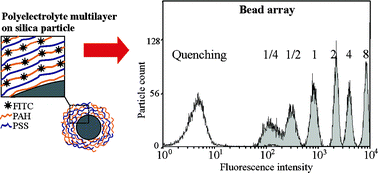Fluorescent bead arrays by means of layer-by-layer polyelectrolyte adsorption
Abstract
Colloids with graduated fluorescence intensities were fabricated by means of layer-wise

* Corresponding authors
a
Institute of Medical Physics and Biophysics, Leipzig University, Härtelstrasse 16-18, Leipzig, Germany
E-mail:
edwin.donath@medizin.uni-leipzig.de
Fax: +49 (0)341 9715749
Tel: +049 (0)341 9715704
Colloids with graduated fluorescence intensities were fabricated by means of layer-wise

 Please wait while we load your content...
Something went wrong. Try again?
Please wait while we load your content...
Something went wrong. Try again?
A. Schnäckel, S. Hiller, U. Reibetanz and E. Donath, Soft Matter, 2007, 3, 200 DOI: 10.1039/B612117A
To request permission to reproduce material from this article, please go to the Copyright Clearance Center request page.
If you are an author contributing to an RSC publication, you do not need to request permission provided correct acknowledgement is given.
If you are the author of this article, you do not need to request permission to reproduce figures and diagrams provided correct acknowledgement is given. If you want to reproduce the whole article in a third-party publication (excluding your thesis/dissertation for which permission is not required) please go to the Copyright Clearance Center request page.
Read more about how to correctly acknowledge RSC content.
 Fetching data from CrossRef.
Fetching data from CrossRef.
This may take some time to load.
Loading related content
